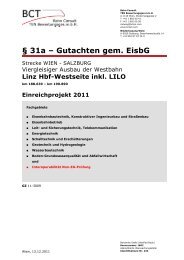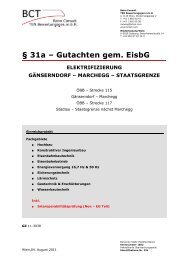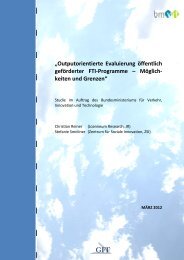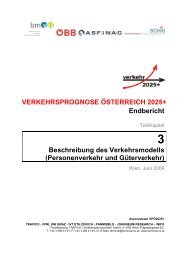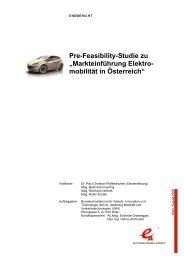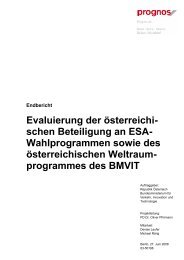Schriftenreihe .;technologiekompetenz Verkehr in
Schriftenreihe .;technologiekompetenz Verkehr in
Schriftenreihe .;technologiekompetenz Verkehr in
Create successful ePaper yourself
Turn your PDF publications into a flip-book with our unique Google optimized e-Paper software.
HYBRID ELECTRIC VEHICLES<br />
Hybrid electric vehicles (HEVs) are a first step towards electric<br />
powertra<strong>in</strong>s, and generally consist of a conventional <strong>in</strong>ternal<br />
combustion eng<strong>in</strong>e (ICE) comb<strong>in</strong>ed with an electric motor. Their<br />
ma<strong>in</strong> advantage is improved overall energy efficiency for the<br />
vehicle <strong>in</strong> urban driv<strong>in</strong>g conditions and therefore a decrease <strong>in</strong><br />
fuel consumption and emissions, whilst simultaneously<br />
guarantee<strong>in</strong>g appropriate range and performance.<br />
HYBRID ELECTRIC VEHICLE CONCEPTS<br />
Generally HEVs can either be classified depend<strong>in</strong>g on the<br />
arrangement of their components or on their degree of<br />
electrification. Accord<strong>in</strong>g to the component arrangement, it is<br />
possible to dist<strong>in</strong>guish between four vehicle concepts.<br />
> Integrated starter generator (ISG) concept, the ICE is directly<br />
connected to a generator and the driveshafts,<br />
> Parallel hybrid concept, an additional clutch separates the ICE<br />
from the electric mach<strong>in</strong>e and the driveshafts,<br />
> Series hybrid concept, the ICE powers a generator and the<br />
driveshaft is electrically driven and<br />
> Comb<strong>in</strong>ed hybrid concept, the ICE can mechanically transfer<br />
the power to the wheels as well as electrically through a<br />
generator and the electric mach<strong>in</strong>e.<br />
For exam<strong>in</strong><strong>in</strong>g the functions of HEVs, it is more reasonable to<br />
classify HEVs accord<strong>in</strong>g to their degree of electrification (figure<br />
1) as it is done <strong>in</strong> the follow<strong>in</strong>g description.<br />
Mico HEV<br />
start/stop function<br />
no e-drive option<br />
Mild HEV<br />
start/stop function<br />
regenarative break<strong>in</strong>g<br />
boost<strong>in</strong>g<br />
no e-drive option<br />
Figure 1: Electric-hybrid powertra<strong>in</strong> concepts based on their degree of electrification<br />
Full HEV<br />
e-drive option (few km)<br />
start/stop function<br />
regenarative break<strong>in</strong>g<br />
14 Austrian Technological Expertise <strong>in</strong> Transport<br />
Micro HEVs mark the first step towards electrification of the<br />
transport sector, They are conventional vehicles <strong>in</strong>tegrat<strong>in</strong>g a<br />
new technique, known as the start/stop system. This system<br />
automatically shuts down the ICE when the vehicle stops and<br />
restarts it when the accelerator is pressed. Micro HEVs offer no<br />
option for an electric drive or electric acceleration (boost<strong>in</strong>g).<br />
Their ma<strong>in</strong> advantage is that they can be realised with only<br />
slightly <strong>in</strong>creased costs. On the other hand they contribute to a<br />
limited extent <strong>in</strong> decreas<strong>in</strong>g CO 2 emissions. Available Micro<br />
HEVs are for example the BMW 1 or the Citroën C3 Stop &<br />
Start. S<strong>in</strong>ce this „light“ hybrid concept can be adapted easily to<br />
a conventional powertra<strong>in</strong> it is expected that many<br />
manufacturers will <strong>in</strong>troduce this system <strong>in</strong> the near future.<br />
Mild HEVs <strong>in</strong>tegrate an electric motor for assistance dur<strong>in</strong>g<br />
acceleration (boost<strong>in</strong>g), which allows a smaller and more<br />
efficient ICE. Furthermore, the electric motor acts <strong>in</strong> reverse as<br />
a generator when the car is brak<strong>in</strong>g, recover<strong>in</strong>g the k<strong>in</strong>etic<br />
energy (recuperation) and charg<strong>in</strong>g the battery. S<strong>in</strong>ce Mild HEVs<br />
do not allow electric driv<strong>in</strong>g, this concept similarly achieves only<br />
small improvements <strong>in</strong> fuel demand compared to conventional<br />
powertra<strong>in</strong>s. However, they allow downsiz<strong>in</strong>g of the ICE without<br />
any reduction <strong>in</strong> performance or comfort, with acceptable extra<br />
cost. A number of manufacturers, such as Honda, Citroen,<br />
Peugeot and Mercedes-Benz, are look<strong>in</strong>g specifically at the<br />
development and market <strong>in</strong>troduction of Mild HEVs. Honda, for<br />
<strong>in</strong>stance, has launched the Honda Civic IMA (Integrated Motor<br />
Assist) and the Honda Insight IMA, and Peugeot has developed<br />
the 307 HDi Hybrid.<br />
Plug-<strong>in</strong> HEV<br />
e-drive option with<br />
higher range<br />
external charg<strong>in</strong>g<br />
EV<br />
pure electric drive










